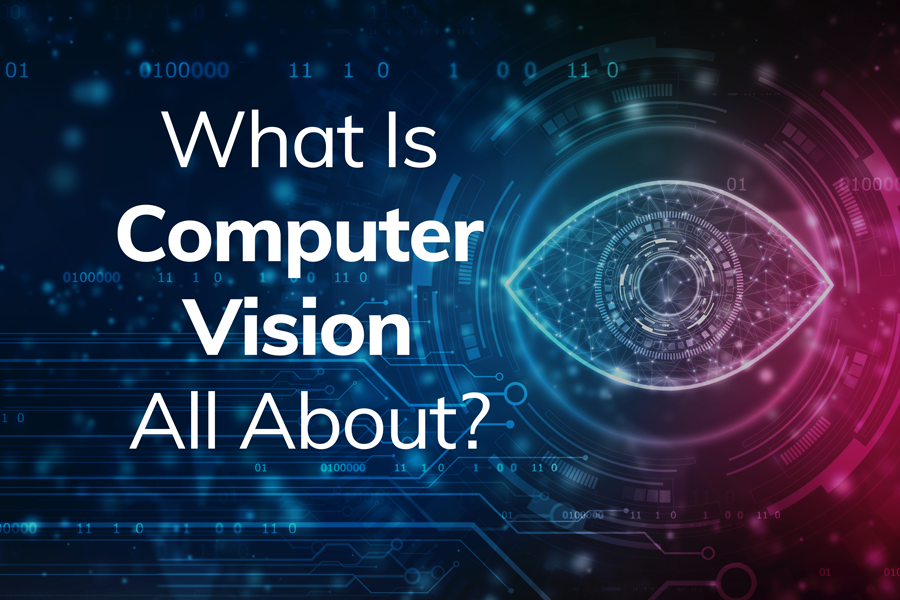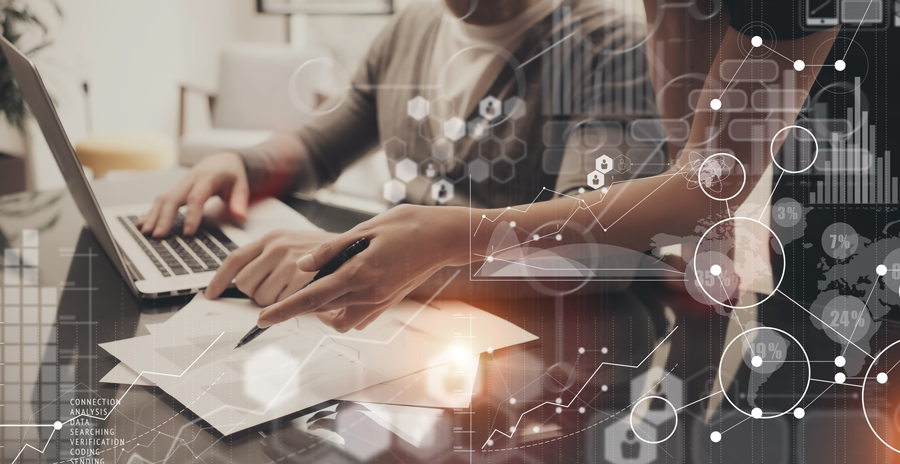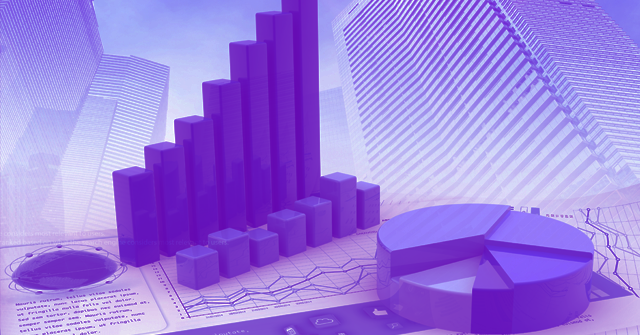What Is Computer Vision All About?
 What is Computer Vision?
What is Computer Vision?
Computer Vision (CV) has increasingly become one of the rapid-paced platforms of artificial intelligence or AI with its recent surge in popularity. The intended purpose of computer vision technology is to mimic the complexity of the human visual system, which includes the eyes, receptors, and the visual cortex. A machine processes and recognizes images and videos like the human brain does more accurately and faster.
Computer Vision Field of Study
This field of study uses computers to replicate the human visual system, a subset of artificial intelligence, collecting information from digital images or videos and processing them to define the attributes.
Acquiring images, analyzing, identifying, screening, and extracting information are involved in extensive processing. The computer understands the visual content and acts on it.
Computer vision projects effectively translate digital visual content into explicit descriptions for gathering multi-dimensional data. This data is then turned into a computer-readable language to aid decision-making.
How does Computer Vision Work?
Computer Vision mainly depends on pattern recognition techniques to self-train and understand the visual data. Deep learning experts use this data for problem-solving by relying on neural networks to make the process faster and more accurate with the help of widely available data and the willingness of organizations such as Google and Amazon to share them.
 Applications of Computer Vision
Applications of Computer Vision
Medical Imaging
Computer vision aids in diagnoses, automatic pathology, MRI reconstruction, machine-based surgeries, and more.
AR/VR
Outside-in tracking, along with inside-out tracking for virtual and augmented reality, including object occlusion or dense depth estimation, is made possible through Computer Vision.
Smartphones
All the QR code scanners, panorama construction, face detectors, image detectors, photo filters, and more that you use are all computer vision applications.
Internet
Image captioning, video categorization, ariel imaging for maps, geolocalization, image search, and more uses computer vision.
Corporations
Image capturing and processing of structured and unstructured data. Data capturing across multiple formats and varied sources.
Computer Vision: Deep Learning Vs. Machine Learning
Both classic machine learning techniques and deep learning methods are leveraged through computer vision.
Developers program the smaller applications for identifying image patterns with the standard ML approach. The images are then classified through the statistical learning algorithm and detect the objects within them. This may require developers to code numerous unique rules into computer vision applications manually, but add deep learning techniques and significant improvement that is brought about.
Deep learning solves problems by identifying patterns in examples based on neural networks. It uses appropriate variables, including the number of neural networks used, and an extensive amount of high-quality training data to be the most effective.

Computer Vision Approaches
When training a model, high-quality image data must be used that is clean, complete, and labeled accurately. The training may use a single approach or a combination of the following four main approaches to interpreting images:
Recognition
The objects in images are identified and interpreted through the computer. For instance, a video is placed that was collected by a self-driving car, or a photo is supplied that identifies stop signs at a four-way intersection.
Reconstruction
The computer detects various motions and recognizes several perspectives of an image using visual sensory data. This approach is most commonly used in mapping, environmental models, and gaming.
Registration
Different data sets are transformed by the computer and blended into a single coordinated system. For example, with augmented reality, computer vision recognizes and locates objects in the environment by measuring the locations of features in the world and tracking them over time as the user moves his or her head. This is combined with data captured through a mounted camera to provide an immersion experience.
Reorganizing
The interpretation of the final approach as a breakdown or grouping of categories in the visual image is made through reorganizing. For instance, a machine could identify a black hockey puck on the ice using computer vision, but with the registration of that puck, the ice skate of the player may interfere. The computer vision system could use pre-labeled data and memory to categorize the hockey puck vs. the player's skate using this method.
Future of Computer Vision
Computer vision is a rapidly developing field that has gained much attention from various industries and looks to function on a broader spectrum in the future.
A steady market of 2.37 million USD is enjoyed by this domain and is expected to witness growth till 2023 at 47% CAGR.

9 Common Tasks Achieved Through Computer Vision
With the evolution of machine vision, there is a large-scale formalization of complex issues into popular solvable issue statements.
Researchers from around the globe have identified problems and worked on them efficiently by dividing topics into well-formed groups with proper terminology.
The following are the popular tasks for computer vision that we regularly discover in AI jargon:
-
Image Classification
Since the release of ImageNet in 2010, Image classification has been one of the extensively studied topics.
Image classification as an issue statement is very simple, being the most popular computer vision task taken up by both beginners and experts.
The task is to classify the given group of images into a set of predefined classes using mainly a collection of sample images already classified.
Image classification deals with processing the complete image as a whole and assigning a specific label to it instead of the complex topics like image segmentation and object detection that localizes the features they are detecting. -
Image Segmentation
Image segmentation is noted as the division of an image into sub-objects or sub-parts for demonstrating that the machine can behold an object from the background and another object in the same image.
Represented through a pixel mask that can be used for extracting it, a segment of an image represents the specific class of object that the neural network has identified in an image. -
Object Detection
Object detection refers to the application of machine vision for detecting objects in a natural environment and localizing them through the bounding boxes with the help of visual data, as its name suggests.
In an image or a video, the object detection searches for the class-specific details and detects them when they pop up. Earlier on, Haar feature, HOG feature, and SIFT features were used to detect features within an image and classify them on the basis of classical machine learning approaches.
This process has severe limitations on the number of objects that can be detected other than being time-consuming and largely inaccurate.
This object detection often comes along with Object Classification or Object Recognition. -
Face and Person Recognition
The subpart of object detection where the main object is being detected, mainly the human face, is Facial Recognition.
Facial Recognition performs not only the detection but also the recognition of the detected face. At the same time, it is similar to object detection as a task that includes the detection and localization of the features.
Facial Recognition searches for the familiar landmarks and features in faces, including the mouth, eyes, and nose, and classifying them with the help of these features and positioning these landmarks. -
Edge Detection
The task of detecting the boundaries in an object is achieved through edge detection.
It uses mathematical methods that aid in detecting the sharp changes or discontinues in the image's brightness is performed algorithmically.
Edge detection is mainly done through traditional image processing-based algorithms and convolutions with specially designed edge detection filters. These are often used as preprocessing steps for several tasks. -
Image Restoration
Restoring or reconstructing the faded and old image hard copies that have been captured and stored improperly, leading to the loss of image quality, is done through image restoration.
There is a reduction of the additive noise through mathematical tools in the processes of typical image restoration. Although reconstruction sometimes leads to further analysis and the use of image inpainting that needs significant changes. -
Feature Matching
The regions of an image that informs us the most about a specific object are through the features in computer vision.
The strong indicators of the object details or features are more localized, and sharp details like the corners also serve as features for the edges. You can now relate the features of one image with those of the other image of a similar region through feature matching.
In important computer vision tasks like camera calibration and object identification is where the applications of feature matching are found.The task of feature matching includes the following:
-
- Detection of features: The Image Processing algorithms like Harris Corner Detection, SURF, and SIFT detect regions of interest.
- Formation of local descriptors: The region surrounding every critical point is captured, and the local descriptors of these regions of interest are obtained after detecting features.
- Feature matching: The features and their local descriptors are matched in the corresponding images to complete the feature-matching step.
-
-
Scene Reconstruction
By forming a point cloud at the object's surface and reconstructing a mesh from this point, the cloud is how most algorithms in scene reconstruction roughly work.
Scene reconstruction is the digital 3D reconstruction of an object from a photograph — one of the most complex problems of computer vision. - Video Motion Analysis
The task in machine vision that refers to the study of moving objects or animals and the trajectory of their bodies is video motion analysis.
The combination of several subtasks, specifically object detection, tracking, segmentation, and pose estimation, is what motion analysis is considered to be.
Computer Vision in Finance
Computer vision provides several benefits to corporate accounting teams by automating and enhancing various aspects of their work. Here are some ways in which computer vision assists corporate accounting teams:
-
Document Scanning and Data Extraction: Computer vision can be used to scan and extract data from various financial documents such as invoices, receipts, purchase orders, and bank statements. This automated data extraction reduces the need for manual data entry, saving time and reducing the risk of human errors.
-
Expense Tracking and Reconciliation: Corporate accounting teams can use computer vision to automatically track and reconcile expenses by scanning and matching receipts and invoices with corresponding transactions in the company's financial records. This ensures accurate and up-to-date financial reporting.
-
Fraud Detection: Computer vision algorithms can analyze images and patterns to detect potential fraudulent activities, such as forged documents or unauthorized alterations to financial records. This helps accounting teams identify and prevent financial fraud more effectively.
-
Audit Support: During audits, computer vision can help automate the process of gathering and organizing financial data and documents, making it easier for auditors to review and verify financial records.
-
Financial Forecasting: Computer vision can analyze historical financial data and market trends to provide insights for financial forecasting and budgeting, helping accounting teams make more informed decisions.
-
Compliance and Reporting: Computer vision can assist in ensuring compliance with financial regulations and standards by automatically flagging potential discrepancies or irregularities in financial records, making it easier for accounting teams to prepare accurate financial reports.
-
Customer and Supplier Verification: For businesses dealing with customers and suppliers, computer vision can help verify the authenticity of identification documents and business licenses, reducing the risk of dealing with fraudulent entities.
-
Data Visualization: Computer vision can be used to create visual representations of financial data, such as charts and graphs, making it easier for accounting teams to analyze and communicate financial information effectively.
By leveraging computer vision technology, corporate accounting teams can streamline their processes, reduce manual workloads, improve accuracy, and make more informed financial decisions. This ultimately contributes to greater efficiency and effectiveness in managing a company's finances.
Computer Vision in a Nutshell: Key Takeaways
Let us note down the things that we can narrow down on what we have learned about computer vision:
- Computer Vision is the subfield of Deep Learning and Artificial Intelligence that allows computers to see and interpret the world around them.
- The application of computer vision technology is relatively new, although it dates back to the 1950s.
- Computer vision is everything about processing, acquiring, and understanding an image's most basic form.
- Facial recognition technology, medical image analysis, surveillance, and self-driving cars are fields that use computer vision applications.
- A computer vision system can surpass the human vision systems these days.

